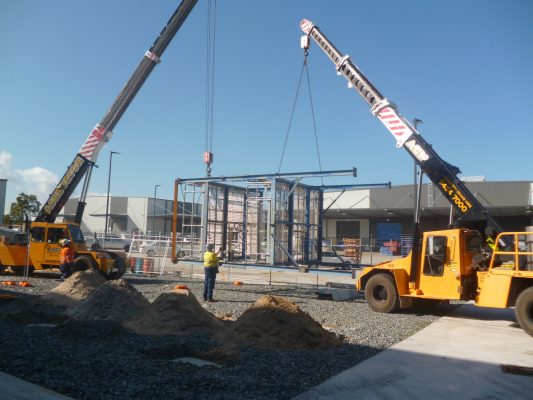
If you are at times confused about the difference between Dogging and Rigging, we don’t blame you. To add to the confusion, some construction companies use these terms interchangeably. While a Rigger is often able to carry out all of the same responsibilities that a Dogman with a High Risk Work License (HRWL) can, they also have more skills which are covered by further licenses that are specific to Rigging duties.
In this blog post, we go into detail on the differences between Dogging and Rigging so that you can decide which training course to enroll in.
DOGGING
What is Dogging?
Dogging consists of two main aspects:
- the application of slinging techniques for the purposes of lifting a load, including selecting the method of lifting (by considering the nature of the load, its mass and the center of gravity) and inspecting lifting gear (for suitability and condition).
- directing the operator of a crane or hoist in the movement of a load when the load is out of the operator’s view.
A Dogger is responsible for the following activities on a worksite:
- Application of slinging techniques
- Determining the weight of the load to be lifted
- The selection and inspection of lifting gear
- The directing of a crane operator in the movement of a load
Who Needs a Dogging License?
A High Risk Work License (HRWL) for Dogging is required by anyone who applies slinging techniques to a load, which includes:
- Calculating the safe angle for sling or chain
- Selecting the type of sling or chain to be used
- Selecting the correct method to secure the load
- Selecting the safe method to lift the load
- Checking the conditions of lifting gear for wear and tear
A Dogging license is also required by anyone directing the operator of a crane or hoist in the movement of a load when the load is out of the operator’s view.
To acquire a Dogging License, you must undertake a Dogging training course with a Registered Training Organisation (RTO). Enrolling in our upcoming Dogging training course is simple via our online booking system or give us a call on 089722 4260.
RIGGING
What is Rigging?
Rigging covers activities such as:
- Moving, placing or securing a load using mechanical load shifting equipment
- Erecting or dismantling cranes of hoists
Mechanical load shifting equipment includes equipment such as cranes, hoists, chain blocks and winch systems.
Who Needs a Rigging License?
There are three classes of Rigging licenses, each with its own description of the type of rigging work that can be performed. The classes are Basic (RB), Intermediate (RI) and Advanced (RA).
A Basic Rigging license is required for people undertaking work where decisions regarding slinging techniques are required such as:
- Movement of plant and equipment
- Erecting precast tilt-up concrete panels and structural steel
- Installation of some hoists (including mast climbing hoists)
- Installing static lines and safety nets
- Installation of cantilevered crane loading platforms
- Installation of perimeter safety screens and shutters
In all cases, the job needs to be appropriately risk assessed by supervisors or management before allocation of the work to determine the requirement for a High Risk Work License.
Like Dogging, you must undertake a Rigging training course with a RTO to obtain a Rigging License. For more information on our Basic Rigging training course or to enroll in an upcoming course, please click here.
To put simply, a rigger is also a dogger because all riggers either have experience or training in dogging. To carry out work as a rigger, you need to have undergone a Dogging training course. That’s why we recommend you to enroll in our Combined Dogging and Basic Rigging course which will allow you to undertake both dogging and basic rigging work.
